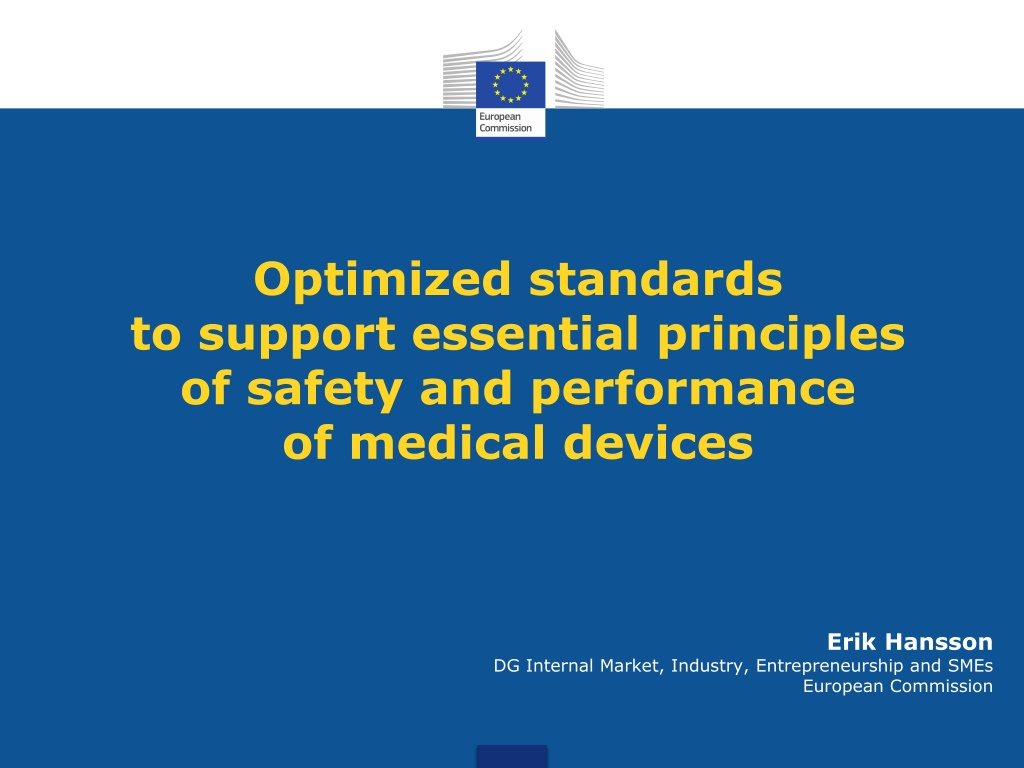Optimized Standards for Medical Device Safety and Performance in the EU
This report discusses the importance of harmonized standards in supporting the safety and performance of medical devices in the EU. It highlights the impact of drafting international medical device standards on EU legislation harmonization and emphasizes the role of harmonized standards under the EU Medical Device Directives/Regulations. The need for updates, scope, and types of harmonized standards are also explored, emphasizing the alignment with international standards for successful harmonization.
Download Presentation

Please find below an Image/Link to download the presentation.
The content on the website is provided AS IS for your information and personal use only. It may not be sold, licensed, or shared on other websites without obtaining consent from the author. Download presentation by click this link. If you encounter any issues during the download, it is possible that the publisher has removed the file from their server.
E N D
Presentation Transcript
Optimized standards to support essential principles of safety and performance of medical devices Erik Hansson DG Internal Market, Industry, Entrepreneurship and SMEs European Commission
Why the drafting of international medical device standards directly impact the harmonisation of standards under the EU legislation? 2
Recap: the EU New Approach (including medical devices and IVD) Presumption of conformity through harmonized standards. References published in the Official Journal of the EU. Annex Z of the standard. 3
Harmonised standards under EU Medical Device Directives/Regulations approx. 300 harmonised standards under Medical Device Directives Updates required for the new Regulations: new request (mandate) to be agreed with Member States and standardisation organisations once new principles for mandates have been resolved. Work already launched. 4
What types of standards can be harmonized in the EU? European standards that has been subject to a mandate (request) to the European standardisation organisations the standard must be suitable for harmonisation to whom is it addressed? what is the scope? why is the harmonisation needed? scope of coverage of ER full partial general collateral product specific - e.g. 60601-X-X family: a single standard (whichever category) cannot provide for Presumption of Conformity on its own this needs to be clearly stated in the standard / Annex Z 5
The role of international standards in harmonisation The European standards for medical devices are in general based on international ISO/IEC standards Agreements between CEN-ISO and CENELEC- IEC 6
How to make the international standards fit for EU harmonisation purposes International standards made to fit regulatory requirements of multiple jurisdictions: EU and other IMDRF members base their legislation on IMDRF documents = use IMDRF essential principles (EP) as starting point. Make explicit which. = use terms and definitions from IMDRF and established and accepted in other standards = explain (rationale) the context - how the standard can be used for demonstrating compliance with EP (including ref. to test methods if applicable) = identify residual risks not covered = identify how to mitigate risks/hazards or give directions on how to address them = associated with acceptance criteria (quantitative, clinical performance etc., generally accepted, validated) justifications when not applied = when needed refer to test methods (sufficient detail and verified) = annex with cross references to IMDRF EP(s) Revisions in TC 7
More reading The IMDRF Standards Working Group document: Optimizing Standards for Regulatory Use (available on the IMDRF website) 8























